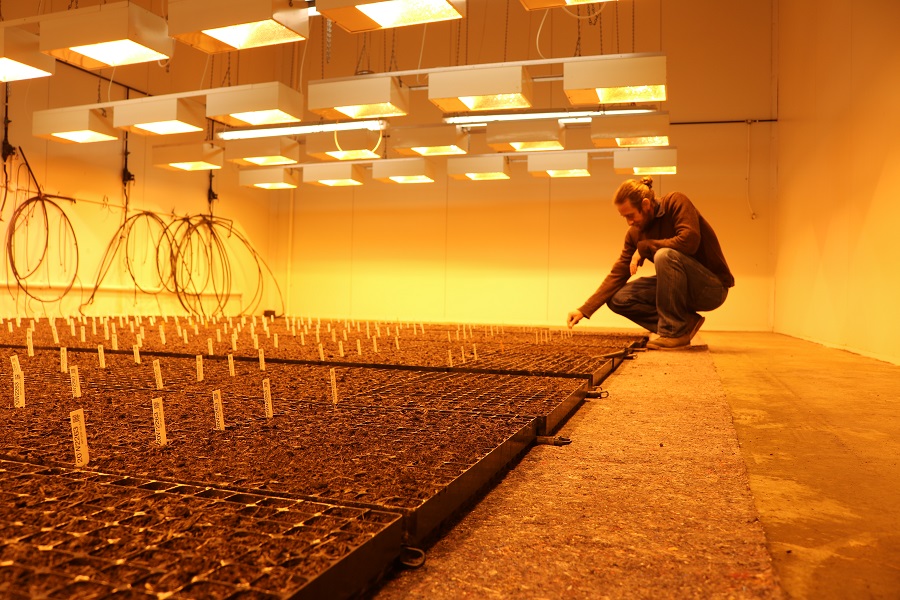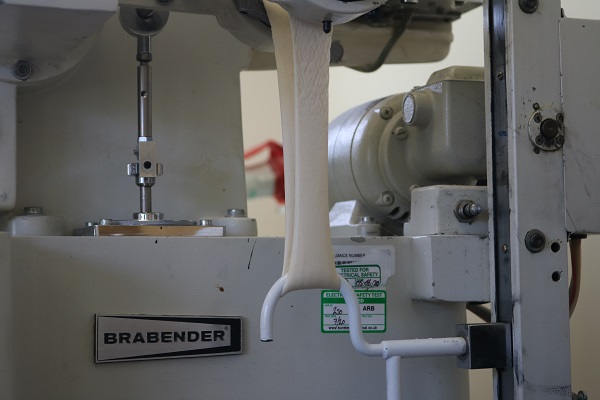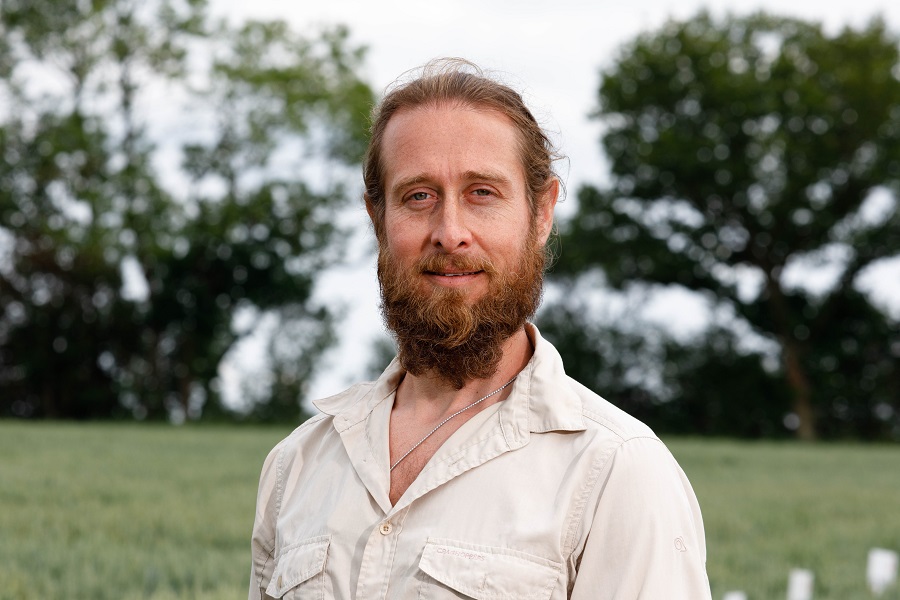
Four new Group 3 varieties may have added a new dimension to the wheats available to put into the field. CPM visits Limagrain UK’s site in Suffolk to explore the properties being introduced into today’s varieties.
The traits now coming through are numerous and the potential is exciting.
By Tom Allen-Stevens
As the tensile tester pulls the roll of dough further and further out of shape, eventually a tear appears and then the stretched band breaks and flops in on itself. Limagrain UK lab technician Eva Lagowski records the result and logs the chart that profiles how this wheat has performed.
“It’s a good test of the protein content, and more importantly the functional protein,” she explains. “We’ve seen some really promising varieties pass through this lab. The question is whether they’ll perform equally well in the field.”
Moving upstairs to the baking lab, you’re greeted by a familiar, comforting smell as the array of home-baking machines are emptied and their freshly baked contents are cut open for comparison. “We judge them on their colour, texture, crumb structure and springiness – these are qualities you can’t test with a machine,” notes Eva.

The tensile tester measures the properties of the functional protein of a potential bread-making wheat variety.
Wheat quality manager Ian Foot takes a close look with Eva at how this latest batch has performed next to the controls in the bake-off – KWS Zyatt, KWS Extase and Crusoe. “Some of these varieties are in their second year of testing, and will go through to National List trials this autumn to be tested by UK Flour Millers (UKFM) next year,” he explains.
“We have four candidates with real potential currently in NL2 trials. Whether we have another Crusoe is hard to say. We’re so close and it’s frustrating when all the key traits you’re looking for don’t match up. Having said that, consistency of performance can only ever be judged in hindsight – Crusoe itself struggled initially to be accepted by millers as a true Group 1 variety, while these days it sets the bread-making standard.”
Ian explains that around 25% of Limagrain UK’s breeding programme is dedicated to bringing through lines with bread-making potential, while the overall investment is a far greater proportion of the company’s activities. Based at Woolpit, Suffolk, the varieties start their existence in growth rooms – large chambers within the facility in which the light and environment are carefully controlled to cycle up to three generations of wheat within the same calendar year.
Limagrain senior wheat breeder Phillip Tailby opens the door on one of these rooms to reveal thousands of tiny pots each with their markers denoting recently planted F1 lines. These have been carefully selected from approximately 30,000 crosses made last year.
“Much of our initial selection is carried out before we have to take these out into the field,” says Phil. “We take tissue samples and analyse the DNA for specific genetic markers we know denote traits, such as resistance to yellow rust – to wait for these to show phenotypically in the field would take years.”
More recent advances in marker-assisted targeted selection have helped breeders like Phil home in on more complex traits, such as specific weight and those that relate directly to yield. The exact nature of the genes and areas of the genome he’s targeting Phil keeps as a closely guarded secret. But there’s an increasingly diverse range of options for him to choose from as the understanding about the incredibly complex wheat genome unravels.
“Limagrain has a global wheat-breeding programme with a good source of germplasm as well as genetic knowledge we have access to. We’re also closely involved with the UK’s public-funded Designing Future Wheats programme looking for the next generation of key traits. This pre-breeding research has looked in detail at new and exotic material, that’s never before been used in UK wheat lines. Interesting finds have been stripped of undesirable traits and brought into UK-adapted lines with genetic markers and germplasm provided free to commercial breeders for us to explore within our own lines.”
Phil points to orange wheat blossom midge resistance as an illustration of what such programmes can achieve. “The traits now coming through are numerous and the potential is exciting – we’ll see a step change in wheats, although it’s still some way off coming to market.”
One success that is commercially available however is a clutch of Group 3 wheats – new introductions to the AHDB Recommended List. These are products of the new breeding techniques Limagrain is using, says Phil, and represent a significant step-on from the wheats currently grown.
“They’re high-yielding, but it’s not yield that’s come at the expense of a good agronomic package. The main advance here is in septoria resistance, but they also have good scores for yellow and brown rust as well as standing ability.”
All four varieties draw the septoria resistance from Cougar in their parentage, although Phil assures this isn’t reliant on single-gene resistance. “That would make the resistance susceptible to breakdown as the septoria pathogen population evolves and adapts. So each has good background resistance as well.
“We closely monitor the performance of our varieties, along with other authorities such as NIAB. But we can’t predict how the populations will evolve, so growers should never rely entirely on genetics to keep crops free of septoria. However, these varieties do represent a resilient base for today’s wheat grower.”
In terms of quality, all meet UKFM Group 3 criteria for biscuit and cake-making and it may this combination of agronomic appeal as well as market suitability that raises prospects for this sector of the soft wheat market. The share taken by Group 3 wheats has been relatively low recently, especially when compared with their hey-day some 15-20 years ago when varieties such as Claire and Consort dominated the wheat area. These found homes in a wide spectrum of the domestic market as well as in grists for overseas millers.
“We’ve not seen quite the same gluten quality we had with those wheats for quite some time,” notes Ian. “We’re working on how we can predict functional protein, but it’s quite difficult to replicate what we had with Claire, for example. Each trait is polygenic and it’s a huge job to get the variables right to produce the combination that delivers the rheology you’re after.
“But we shouldn’t be of a mindset that Group 3s are just for biscuits or cakes. LG Illuminate meets the uks specification for export, for example. LG Astronomer makes slightly stronger dough, but it’s a fantastic variety in its own right – having good grower appeal often helps the prospects for a Group 3 variety.”
Phil confirms that he’s looking to improve early selection for quality criteria. “The growing environment is challenging, but we’ve developed opportunities using the tools at our disposal that are making selection easier. That’s built on our collaborative programmes and we’re starting to see high-yielding wheats come forward now with good septoria resistance, pushing higher specific weights – a consistently reliable package for the grower. That’s a huge advance over where we were 10-15 years ago, and I’m hopeful we’ll see the same step change in how we select for quality in years to come.”
Greater potential from soft wheat line-up
The four new Group 3 wheats open up the choice for growers this autumn and provide real opportunities to capture a quality premium, says Limagrain cereals and pulses product manager Tom Barker.
“Growers now have the same opportunity in Group 3 they’ve had from soft Group 4 varieties. Grow them as a feed wheat for the high yields and good agronomics, but there’s the potential there for premium, and as Group 3 types, that opens up the cake and biscuit markets,” he says.
LG Prince leads the Group 3 line-up and shows particularly strong performance in the East, he notes. “It also has real second wheat potential and performs well on heavy soils. A later-maturing variety, it’s short strawed with a high score for septoria and yellow rust.
“When it comes to agronomics, though, LG Astronomer leads the pack, with one of the highest untreated yields on the AHDB Recommended List. That comes from its very strong septoria resistance as well as a score of 9 for yellow rust. Earlier maturing, it also has stiff straw and excellent grain quality.
“LG Illuminate is the one that ticks all the boxes for market potential, though. It meets uks soft wheat requirements for export as well as looking a strong candidate for cakes and biscuits. That’s coupled with the same high yields and similar disease-resistance profile to its stable mates. Suitable for early drilling, it’s also a good choice for northern growers with distilling potential,” notes Tom.
For growers looking for yield, LG Skyscraper still leads the list. “It’s the soft Group 4 that’s doing exceptionally well in terms of market share, proving very popular in the east of England and in Scotland. LG Spotlight does slightly better in terms of quality, with a good specific weight.”
Tom also flags up two promising hard Group 4 candidate varieties. “LG Farrier looks to be the out-and-out variety for yield from this year’s candidates – a cross of Costello with Evolution it also has a good specific weight. LG Typhoon has exceptional disease-resistance scores, stiff straw and OWBM resistance.”
Inside traits
Sustainable agriculture is moving to a new era in which plant genetics play a greater role in the integrated crop management toolbox growers utilise to get the best from their crops. In this series, CPM has teamed up with Limagrain to give growers insight into these new tools. Through privileged access to staff and related research these articles look inside the traits, explore the genetics and unlock the secrets of a successful crop.
Limagrain started 50 years ago as a farmer-owned co-operative in France, and is now fourth largest seed company worldwide. With an annual turnover of nearly €1.9 billion, 16% of this is spent on R&D. By developing varieties with higher yields, improved resource efficiency and reduced environmental impact, Limagrain is a major contributor to meeting agriculture’s sustainability goals. And this guides the company’s raison d’être: to cooperate for the advancement of agriculture everywhere, for everyone.




